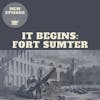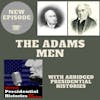It Begins: Fort Sumter

The election of Abraham Lincoln as the sixteenth president of the United States prompted states throughout the south to announce their desire to leave. Trying to maintain federal authority where it could, Lincoln entered office hoping to restock Fort Sumter, set in the bay of the Charleston Harbor.
The first battle of the Civil War, Fort Sumter ignited what had been building for months. Join me this week as I dive into the battle of Fort Sumter. What happened? And why was Fort Sumter so important?
SOURCES
Bordewich, Fergus. “Fort Sumter: The Civil War Begins.” April 2011. Smithsonian Magazine. (LINK)
Lincoln, Abraham. “First Inaugural Address of Abraham Lincoln.” March 4, 1861. Courtesy of the Avalon Project. (LINK)
Library of Congress, “Timeline of the Civil War: Articles and Essays.” (LINK)
“Constitution of the Confederate States of America.” March 11, 1861. Courtesy of the Avalon Project. (LINK)
“The power confided to me will be used to hold, occupy, and possess the property and places belonging to the Government and to collect the duties and imposts; but beyond what may be necessary for these objects, there will be no invasion, no using of force against or among the people anywhere. Where hostility to the United States in any interior locality shall be so great and universal as to prevent competent resident citizens from holding the Federal offices, there will be no attempt to force obnoxious strangers among the people for that object. While the strict legal right may exist in the Government to enforce the exercise of these offices, the attempt to do so would be so irritating and so nearly impracticable withal that I deem it better to forego for the time the uses of such offices. Abraham Lincoln March 4, 1861.
Welcome to Civics and Coffee. My name is Alycia and I am a self-professed history nerd. Each week, I am going to chat about a topic on U.S history and give you both the highlights and occasionally break down some of the complexities in history; and share stories you may not remember learning in high school. All in the time it takes to enjoy a cup of coffee.
INTRO MUSIC
Hey everyone, welcome back.
I hope you all had a wonderful holiday season and that your new year is getting off to a good start. A few weeks, we began our Civil War journey with the election of 1860. As I mentioned in that episode, the election of Abraham Lincoln in 1860 was one of the most consequential events in American history, acting as the final nail in the proverbial coffin as South Carolin sUSEEDed from the union just a month later.
However, the true official start date of the Civil War wouldn’t come for several more months when, in April 1861, Fort Sumter fell to confederate hands. So this week, I am talking about the events surrounding Fort Sumter. Who was involved? What happened? And what was so important about the federal fort?
Grab your cup of coffee, peeps. Let’s do this.
Before we dive into the first official battle of the war, lets pull back a little and study the timeline of events that led to the conflict. As I mentioned a few weeks ago, the election of 1860 was a bit chaotic with four candidates and a third political party all vying for the top spot in the White House. Despite his failure to win any votes in the South, Abraham Lincoln squeaked in a victory, becoming the nation’s 16th president.
However, unlike today where the president-elect is sworn in in January, in 1860 Lincoln would have to wait several months before taking office, as inauguration day was in March until the twentieth century. This meant that there were months for disaffected citizens to contemplate ways to make their displeasure known.
South Carolina led the charge by announcing their plans to secede (suSEED) from the United States just weeks after Lincoln’s victory, prompting several other southern states to follow suit. But did leaving the union actually mean? Would the former states all become little republics? Would they try to make treaties with each other for trade? Or would they bind together?
Of course, if you know your American history, then you know that they chose to come together and create a confederation of sorts, all built on their shared desire to maintain slavery. Meeting together in Montgomery, Alabama in February 1861, representatives from seven states gathered together to write up the framework of their new government. The Confederate Constitution comprised seven articles and heavily mirrored the federal constitution, including counting their enslaved population as ⅗ of a person and tying house representation to population. However, the confederate constitution differed in a few ways. Namely, their constitution explicitly forbade the congress from writing or otherwise implementing any laws quote: “denying or impairing the right of property in negro slaves,” end quote and allowing the president to serve for 6 years instead of four. However, unlike the federal constitution, the confederate version explicitly limited the president to a single term. Jefferson Davis was listed as the confederacy’s interim president until elections could be held and the constitution was officially ratified on March 11, 1861 just under a week after Lincoln’s inauguration.
In Washington, lame duck President Buchanan continued his stance of passivity toward the neighbors to the south. As South Carolina and other states announced their intention to depart from the United States, Buchanan sat idly by, failing to take any action. His inability to hold the southern states accountable continued as residents throughout the southern half of the country seized federal property and refused to allow the federal government to restock the forts. This includes an attempt in February 1861 when South Carolina troops barred a federal supply ship from entering the bay to restock Fort Sumter. Unable to access the military post and without a clear mandate or explicit instruction from the President, the ship was forced to reverse course and head back north to New York. While Buchanan stated the actions of the south were illegal, he claimed there was little for him to do, effectively leaving a mess for his successor to handle. Buchanan’s ineffective leadership prompted many to believe the Union represented a dying democracy and would not be able to survive the challenge from the south.
For his part, Lincoln believed war could be avoided and that all the secession activity was the result of an overzealous minority and that the actions did not truly reflect the will of local residents. Using his speech as an expression of good faith and unity, Lincoln shared his views about the institution of slavery - a portion of which I read at the beginning of the episode. The new chief executive also presented an argument that the federal constitution provided no path to allow for a single state to leave on its own and therefore, as far as he was concerned, all of the federal functions of the government, like mail, would remain in place. He used his speech to promote calm and try to unite the country, asking the citizens of the southern states to really consider the ramifications of trying to secede from the United States, saying partially quote: “before entering upon so grave a matter as the destruction of our national fabric with all its benefits, its memories, and its hopes, would it not be wise to ascertain precisely why we do it?” end quote.
Lincoln was sure to point out that governments must allow compromise; by choosing to leave without engaging in a dialogue, Lincoln argued, the states in question were setting a dangerous precedent. What was to stop southern states from seceding again over a disagreement? Lastly, he promised that he would not be the one to strike the first blow, saying quote: “in your hands, my dissatisfied fellow-countrymen, and not in mine, is the momentous issue of Civil War,” end quote.
Once in office, Lincoln had several logistical issues to contend with, such as how to communicate with the states who seceded. As President, Lincoln knew that any negotiation or other engagement with the confederate government would be granting official recognition. But he also wanted to seek a solution that brought the states back into the Union and avoided further discord. As such, he chose to communicate only with the Governors. Despite their voting for secession and support of the confederacy, it was the better option. In ordering the resupply of Fort Sumter, the President notified South Carolina Governor Francis Pickens hoping the advanced warning would diminish any fears of attack. The President also let it be known that if the ship was fired upon, he was prepared to send in troops to enforce federal authority.
However, residents of South Carolina had little trust in the government in DC. Whipped into a frenzy throughout the election, many southern residents were not only distrustful, but outright terrified of what a President Lincoln could mean for their way of life. So when he issued his advanced notice, a number of South Carolinians believed it was all a ruse and that a federal attack was imminent, prompting their demand that the commander of the fort vacate immediately. South Carolina responded to the President, claiming that any attempts to reinforce the fort would be viewed as an act of aggression and a local paper declaring quote: “we will meet the invader, and the God of Battles must decide the issue between the hostile hirelings of abolition hate and northern tyranny,” end quote. The two sides continued to inch closer toward the inevitable, but both misjudged the other. Many southerners believed they could peaceably leave the United States and avoid any violent confrontation, while Lincoln and many in the North believed southerners would never fire upon Fort Sumter.
But what was so important about Fort Sumter? Primarily, location. Set in the middle of Charleston harbor, Fort Sumter represented one of three military fortifications built by the federal government to protect the area. Charleston Harbor was a very important southern port and represented one of the last remaining strongholds of federal authority in the south, with the other being Fort Pickens in Florida. Historians of the Civil War highlight that control of Fort Sumter represented a direct challenge to secessionists claims of self-sovereignty. As long as the federal government maintained control of the fort, they demonstrated that the southern states did not have the authority they claimed in their declaration of secession.
Seeking counsel, some of Lincoln’s cabinet suggested the President let go of the fort and appease the south. However, the President believed doing so would send the wrong message and would prompt not only a loss of confidence, but would also contradict everything he had been saying up to that point, which was that there was no mechanism that allowed for the creation of a new nation. Lincoln faced the first of several difficult choices; he could not in good faith make one of his first acts as President a conciliatory action toward an area in active rebellion, but he also could not be the one to order the first act of aggression. He continued to remain hopeful that war would be avoidable. He would soon learn just how wrong he was.
Originally set up at nearby Fort Moultrie, commander Robert Anderson moved his nearly one hundred men to the more defensible Fort Sumter. Seemingly itching for a fight, committed secessionists, referred to as fire-eaters, painted Anderson’s move as evidence that the federal government was denying the state’s peaceful efforts to secede. Calling on men to come and defend their way of life, elite’s played heavily on fears of racial equality, claiming that failure to defend the south would lead to whites becoming slaves for blacks. The area surrounding Fort Sumter was quickly surrounded as nearly three thousand men set up camp, ready for the order to advance.
On April 11, representatives of the confederacy issued their demand to Anderson: evacuate the fort and the men would be allowed to maintain control of their weapons. Anderson, who remained fiercely loyal to the Union despite being a Kentucky born former slave owner, responded, quote: “I regret that my sense of honor, and of my obligation to my government, prevent my compliance,” end quote. The truth was, Anderson was on an island - both literally and figuratively. Communication was difficult in the nineteenth century, especially in hostile territory where federal officials were largely prevented from being able to access the island.
This meant Anderson had to largely negotiate and determine the best course of action alone. His second in command, Abner Doubleday, was impressed with Anderson’s restraint, later writing quote: “he knew the first shot fired by us would light the flames of a civil war that would convulse the world, and tried to put off the evil day as long as possible,” end quote. Described as both a soldier and seasoned diplomat, Robert Anderson did everything in his power to buy time. However, he was quickly running out of supplies and with no restock coming, he knew time was not on his side. When confederate representatives issued another demand on April 12 to surrender immediately, Anderson met with his men and took a vote. Should they acquiesce? The men said no.
Anderson then asked what remained of their limited supplies and discovered the fort could be protected for only a few days at most, and would require his men to go without food. With this knowledge in hand, Anderson made the difficult choice to tell his antagonizers that he and his men would vacate the fort, but until the 15th of April - three days away. The confederates refused his conditions, issuing a notice of their intent to fire upon the military fortification within the hour. Anderson prepared his men and at 4:30am on April 12, 1861 the first shots of the Civil War were fired.
Anderson and his men did their best to protect the fort while conserving their minimal reserves. This meant the fort was bombarded with cannon for over two hours before Anderson fired back. Local residents, eager and anxious, went to their rooftops to watch as the federal military post withstood shot after shot. The fort was quickly surrounded by fire, leaving the union men without many options. Anderson and his men protected the fort for just under two days before finally surrendering command on April 14th, 1861. The surrender of the fort was a bit of a frustrating experience as Anderson originally negotiated with Louis T Wigfall, who claimed he was a qualified member of the confederacy only to learn later Wigfall had no such authority. Regardless, Anderson restated his terms for surrender and with the approval of confederate General P.G.T. Beauregard, Anderson and his men vacated Fort Sumter. Despite nearly 3,000 cannon shots, neither side suffered a casualty. In fact, the first two deaths of the Civil War would actually come as the result of an accident.
With the fall of Fort Sumter, the confederacy now maintained control of an important southern port and was able to claim the first victory. In the North, President Lincoln called for volunteers to help recapture federal territory, hoping the conflict would be quickly over. Instead, the Civil War would drag on for four years and claim over 600,000 American lives, including the sixteenth president.
Be sure to come back next week as we dive deeper into the various aspects of the Civil War. And it is not too late to put in your idea - you can find me on all the socials including Instagram, Bluesky, and Threads. I have already received some great suggestions from you so please - keep them coming!
Thanks, peeps. I will see you next week.
Thanks for tuning and I hope you enjoyed this episode of Civics & Coffee. If you want to hear more small snippets from american history, be sure to subscribe wherever you get your podcasts. Thanks for listening and I look forward to our next cup of coffee together.
OUTRO MUSIC
Listener Favorites
Not sure where to begin? Take a listen to some fan favorites.

























